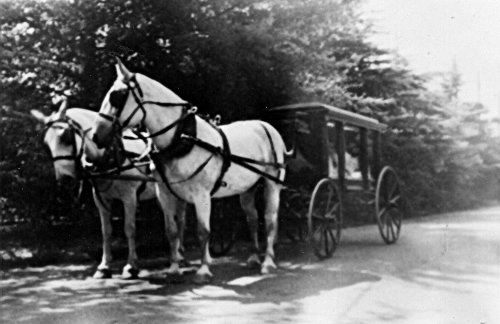
Updated March 30, 2014.
June 24, 2010. From the Melinda Lukei Collection.
Interviews are from THE ISLANDERS. A publication produced by the Knotts Island Junior Historians at the Elementary School under the guidiance of Faye Freeman. These interviews are from Volume 1 of 1987.
Mr. Mahlon "Mike" Wade. Interviewed by Jr. Historian Club. Story written by Paul Thorn. Today the closest funeral homes are in Virginia Beach, thirty—five miles away. Mr. Mike Wade, 77, a Knotts Island native, was interviewed by the Knotts Island Jr. Historians about funeral arrangements on Knotts Island. Back in the early l900's people were not embalmed. If you died one day, you were buried the next day. The undertaker, William "Dick" Morris, made the caskets himself. "They had a hearse and a mule pulled it." If someone died, the people told the neighbors and the neighbors came over and cleaned the dead person, put them in their best clothes, and laid the person on their bed until time for the burial. The neighbors didn't charge anything for this chore. "There was always someone who sat with the dead person." The undertaker would bring the mule or donkey, casket, the little hearse and they would put the deceased in the casket. They had funeral services in the church like we do today. "Neighbors would bring a few little flowers." The tombstones were bought in Virginia Beach and Norfolk. You had to go pick it up and put it down yourself.
Mrs. Edna White Carroll. Interviewed by Jr. Historian Club. Story written by Keith Hodges & Melissa Dianne Watts. In earlier times when people died their funeral arrangements were made on Knotts Island. But now people must go thirty miles to the nearest funeral home. We d1dn't really have a funeral home. Mr. Dick Morris was in charge of taking care of the bodies. He lived right beside the cemetery. His house was to the right of the cemetery. I don't know how he went about preparing the bodies. I don't think they were embalmed. Most of them were kept at home overnight. He would come and fix them. Then he would carry them to the graveyard, with a hearse drawn by horses. I don't think he dressed the bodies, the families did that. I'm pretty sure he built the coffins too. All the bodies were kept at home for viewing. As far as I can remember they were only kept for about two days. People used to bring food, and say they were sorry, just like we do today. We had preachers, just like we do today, that held the services. We also had funerals at the Methodist and Baptist Churches too. Services were in the church and then we went to the grave. I think the first funeral I can remember was at the Baptist Church. That was my mother's brother. He was killed in World War I. He went to the church in a horse and cart. We took him to the Baptist Church. The graveyard was in the field, just this side of old Jones store. He was the only one killed in World war I, who lived on Knotts Island.
Casey Munden. Interviewed by Suzanne Flannagan & Brandy Futrell. Story written by Wendy Delfenthal. In his inerview with Jr. Historians, Mr. Munden gave this account of early funeral arrangements. We had an undertaker over here; built his own coffins I donlt know what they were made of. He had one old hearse over here that was pulled by a horse. One single team and that was used over here for several years. After that some guy toward Back Bay, (Virginia Beach, about fifteen miles from Knotts Island) his name was Grimm, Mr. Grimm. He had a little office over there that he kept dead people in till time to bury them.
Mrs. Bessie Cason. Interviewed by Sherry Cason. Story written by Sherry Cason. Mrs. Bessie Cason, 77, recalled what the funeral homes were like on Knotts Island. There was only one (funeral home) on the Island. Dick Morris was the man that run it. He made the coffins. He had a hearse. The funeral home was where the house is now, up there where the cemetery is. A building is where he made the coffins. In a shed is where they kept the hearse. They didn't embalm them like they do now. When they died, the family dressed them, and sat up with them. They were buried the following day.